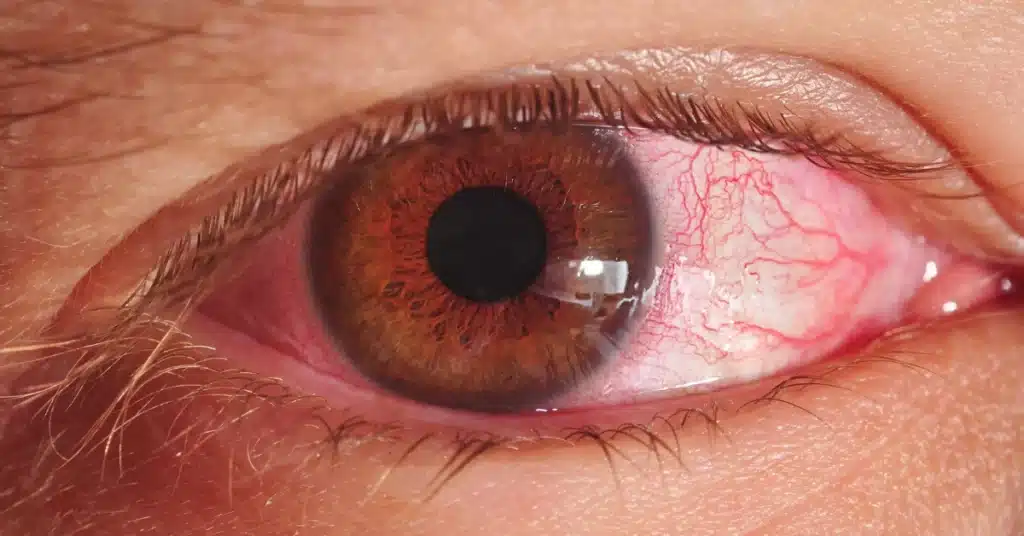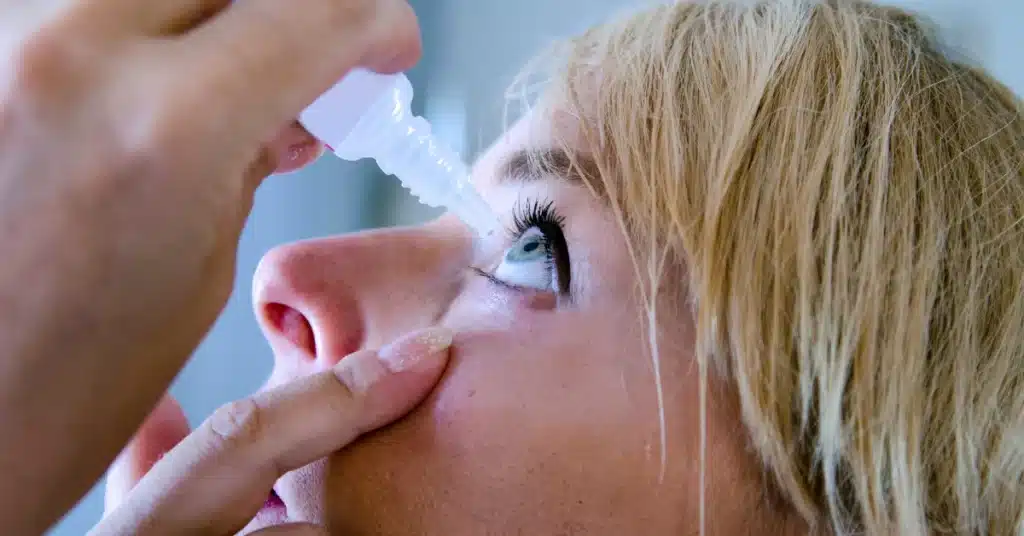Viral pink eye, medically known as Viral Conjunctivitis, is a common eye condition caused by viral infections.
Conjunctivitis involves the inflammation of the tissue lining the eyelid (conjunctiva), which can spread due to various factors, including viruses.
Viral pink eye is common but mild. However, understanding its characteristics and potential complications is crucial.
This article provides a thorough overview of viral pink eye, covering its symptoms, causes, contagion, duration, and treatment options.
What is viral pink eye
Viral pink eye is an infection that involves the inflammation of the conjunctiva — a thin mucous membrane lining the inner eyelids.
This condition develops due to viral eye infections often caused by adenoviruses. It can also result from enteroviruses and herpes simplex virus.
Viral Conjunctivitis usually originates in one eye and spreads to the other. It is the most common type of pink eye.
Understand the difference between bacterial and viral pink eye with our article: Viral vs Bacterial Pink Eye: Causes, Symptoms, and Treatment
Viral pink eye symptoms
 Source: dtimiraos_from_Getty_Images
Source: dtimiraos_from_Getty_ImagesThe common symptoms of viral pink eye include red eyes, excessive tearing, itching, and a gritty sensation in the eyes.
In addition, patients might notice sensitivity to light and watery discharge. Typically, these symptoms start in one eye and can later extend to the other.
Let us discuss the symptoms of viral pink eye:
- Redness in the white part of the eye, indicating inflammation or swelling of the conjunctiva
- Excessive tearing, which can lead to a watery discharge from the affected eye
- Eye itchiness or burning sensation, causing discomfort
- A sensation of having a foreign object or grit in the eye
- Sensitivity and irritability when exposed to light
- Swelling of the conjunctiva, the clear layer covering the white part of the eye and inner eyelids
- A crusty residue around the eyelids caused by the discharge, especially in the morning
- Temporarily effect on vision due to swelling or discharge
- Swollen or tender lymph nodes around the ears or neck
Shop Now: Eye care at GoodRxMedicine
What causes viral pink eye
Infections from viruses, especially from adenovirus, are the primary cause of viral pink eye. Adenovirus is responsible for about 75% of viral pink eye cases.
According to the American Academy of Ophthalmology (AAO), this is the same virus that causes sore throat or runny noses.
Therefore, you can also get viral pink eye with cold symptoms. Viral pink eye and sore throat or cold often accompany each other.
In addition, other viruses, such as enteroviruses and herpes simplex, can also cause pink eye infections.
These viruses are highly contagious and readily spread through direct contact with eye secretions or respiratory droplets from infected individuals.
They can also be transmitted by touching contaminated surfaces or objects.
Recommended read: Wondering why pink eye keeps coming back? Learn what causes it — Uncovering Pink Eye Causes: A Comprehensive Guide
Transmission of viral pink eye infection
Viral pink eye is extremely contagious and can readily spread from one person to another. It can spread from direct contact, indirect contact, or airborne transmission.
Let us learn if viral pink eye is contagious and how it spreads.
Is viral pink eye contagious
Viral pink eye is an extremely contagious infection.
It is readily transmitted through direct contact with the eye discharge or respiratory droplets of infected individuals.
Additionally, the virus can be transmitted by contacting contaminated surfaces or objects.
It is crucial to maintain good hygiene and exercise necessary precautions to prevent the spread of the virus.
If you suspect you have viral pink eye, it is best to seek immediate medical attention. A doctor can provide an accurate diagnosis and prescribe the right treatment to prevent the spread.
Know what is pink eye discharge with our article: Is Pink Eye Discharge Normal: What You Need to Know
How does viral pink eye spread
Viral pink eye can spread through various means, such as direct or indirect contact and airborne transmission.
Direct contact: The virus can be transmitted by direct contact with an infected individual’s eye discharge, when shaking hands, touching someone’s face, or having close personal contact
Indirect contact: The virus can also be contracted indirectly through contaminated surfaces or objects.
Individuals with pink eyes can spread the infection by touching a surface. This surface becomes contaminated, and anyone who comes into contact with it becomes infected.
Airborne transmission: In close-contact settings, viral particles can become airborne in respiratory aerosols. Inhaling these particles can lead to infection.
Want to know for how long is pink eye contagious? Read our article: How Long is Pink Eye Contagious and How to Prevent Spreading It?
How long does viral pink eye last
The duration of viral pink eye can vary based on the virus causing the infection and individual factors.
Typically, the viral pink eye contagious period lasts between 10 to 14 days. However, some cases may resolve sooner, while others may persist longer.
It’s important to seek proper medical advice for accurate diagnosis and guidance on managing the condition.
Recommended read: Wondering when your pink eye will go away? Learn about its duration and effective relief — How Long Does Pink Eye Last: From Onset to Recovery
Treatment of viral pink eye
 Source: Syda_Productions
Source: Syda_ProductionsAs a viral infection causes viral pink eye, antibiotics designed for bacterial infections are ineffective against it. It usually goes away on its own in 1 to 2 weeks.
The treatment of viral pink eye primarily involves supportive care and managing symptoms. Some ways to manage viral pink eye symptoms include:
- Apply warm compresses to soothe discomfort
- Clean the infected eye with a cotton ball or clean cloth soaked in warm water
- Use over-the-counter artificial tear solutions for relief from dry eyes and irritation
- Refrain from wearing contact lenses until the infection has cleared, as they can further irritate the eyes
- Antiviral medications may be recommended if the infection is severe or caused by a specific virus like herpes simplex
Key takeaways
Viral pink eye is a type of Conjunctivitis that occurs due to viral infections, which lead to the inflammation of the conjunctiva.
It is often caused by adenovirus but can also result from other viruses such as enteroviruses and herpes simplex.
The common symptoms of this condition are swelling, redness, itchiness, grittiness, and a watery discharge.
Viral pink is usually a self-limiting condition (resolves without treatment). However, the contagious nature and bothersome symptoms of this infection may often require attention.
It is essential to seek medical advice and practice healthy sanitation to relieve the effects of viral pink eye.
Remember, if you suspect you have viral pink eye or experience severe symptoms, consult a healthcare professional for appropriate diagnosis and guidance.
Frequently Asked Questions
Is pink eye viral?
Pink eye can be viral, bacterial, or allergic in origin. Viral pink eye, also known as Viral Conjunctivitis, is caused by viruses such as adenoviruses.
How do you get viral pink eye?
Pink eye is typically contracted by direct contact with infected eye secretions or respiratory droplets or by handling contaminated surfaces or objects.
Does viral pink eye have discharge?
Yes, viral pink eye frequently causes a watery discharge from the affected eye, as well as other symptoms such as redness and itching.
Is Viral Conjunctivitis pink eye?
Yes, Viral Conjunctivitis is also known as pink eye due to the distinctive redness and inflammation of the eye.
How long is viral pink eye contagious?
Viral pink eye is usually contagious for one to two weeks. However, this might vary depending on the infection and individual variables.
Does viral pink eye go away on its own?
Yes, viral pink eye usually resolves on its own after one to two weeks. Supportive care and good sanitation practices can help in recovery. If severe, antiviral medications may be prescribed.
When referencing outside resources, GoodRxMedicine always provides full citations. To learn more about the measures we use to maintain the quality of our content, please review our Content Information Policy.











